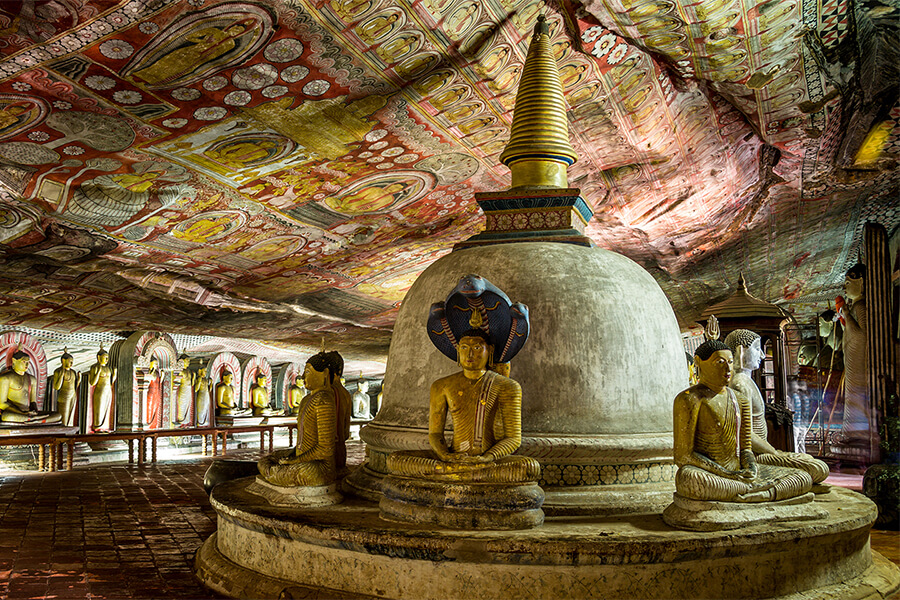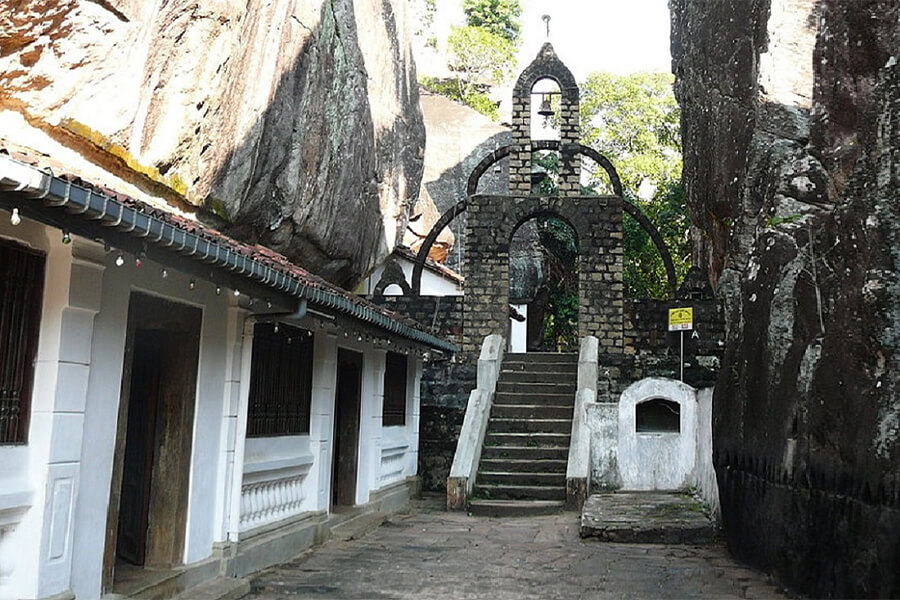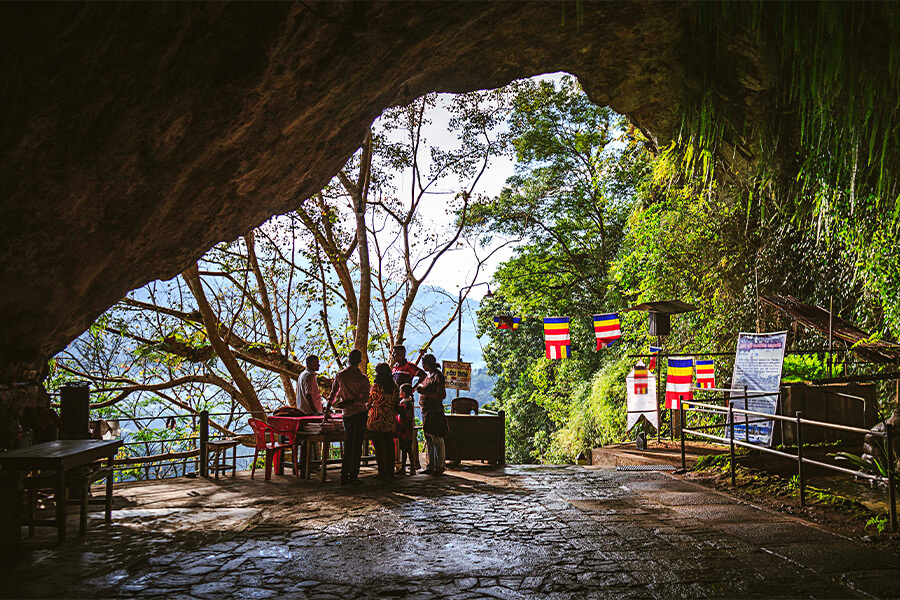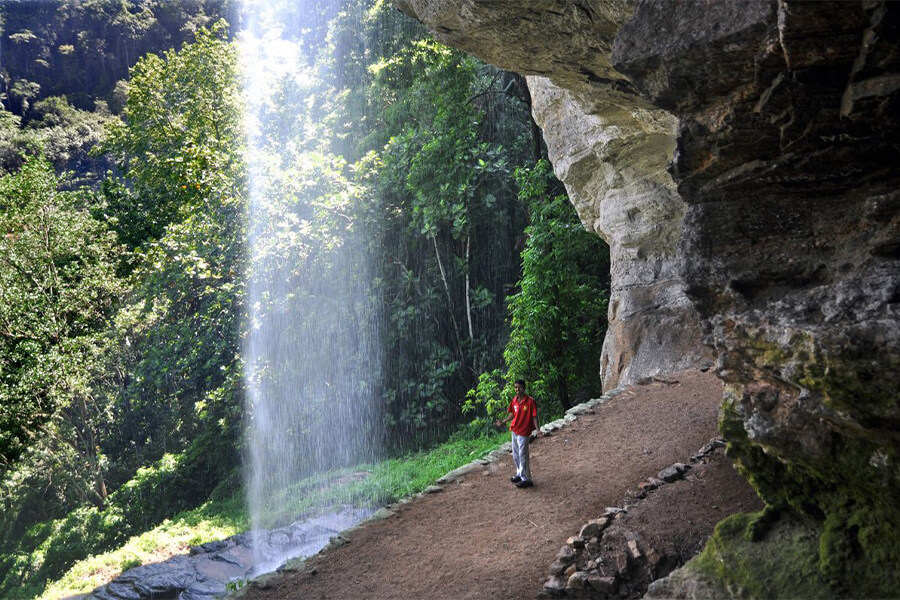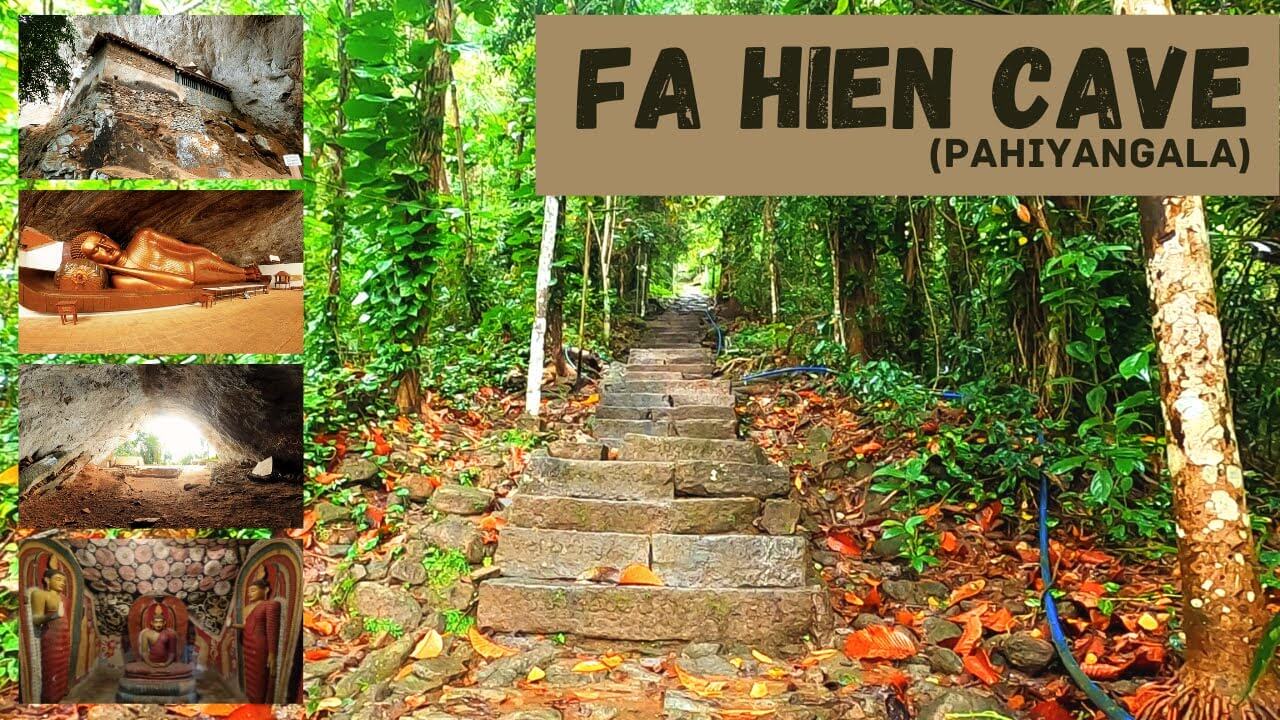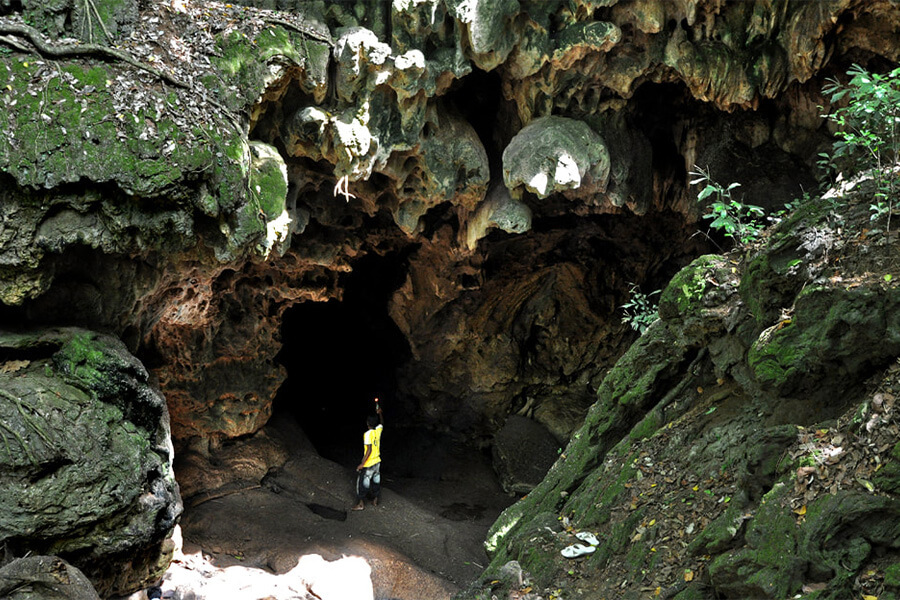Sri Lanka is famous for golden beaches and emerald tea hills, but hidden beneath the surface is another world entirely – a network of ancient shrines, prehistoric dwellings and limestone caverns that tell the island’s deeper story. Exploring the most remarkable caves in Sri Lanka is not just about geology; it’s about kings and monks, folklore and archaeology, jungle treks and quiet village life. Whether you’re planning tailor-made Sri Lanka travel packages or a one-off day trip from Kandy, Colombo or Ella, these cave sites add depth – literally and figuratively – to your journey. In this guide, we’ll walk through some of the most iconic Sri Lanka caves, how to visit them safely and respectfully, and what makes each Sri Lanka cave unique.
From UNESCO-listed temple complexes to wild underground rivers, the following caves in Sri Lanka are among the most rewarding stops for culture lovers, photographers and adventure seekers alike.
Dambulla Cave Temple - Iconic Caves in Sri Lanka
If you visit only one cave in Sri Lanka, let it be Dambulla. Also known as the Golden Temple of Dambulla, this UNESCO World Heritage Site is the most famous of all caves in Sri Lanka, and for good reason. Perched on a giant rock outcrop above the plains of the Cultural Triangle, the complex contains more than 150 Buddha statues and exquisite ceiling frescoes that have been preserved and repainted over centuries.
Dambulla is not a single Sri Lanka cave, but a series of five main cave shrines, each with a different atmosphere. The largest, Maharaja Vihara, feels like a cathedral carved into stone, with large recumbent Buddhas, painted pillars and soft lamplight highlighting the contours of the rock. The painted ceilings – dense with floral motifs, demons, gods and historical scenes – are some of the most impressive in any Sri Lanka caves.
From a traveler’s perspective, the experience starts before you even enter the caves. After buying your ticket, you climb a series of steps up the rock, with views over the surrounding countryside and the distant Sigiriya rock fortress. In the dry season, the path can be hot and exposed, so it’s wise to start early, carry water and wear a hat. As with many temple caves in Sri Lanka, you’ll need to remove shoes at the entrance and dress modestly (shoulders and knees covered).
- Visit in the morning or late afternoon to avoid the midday sun and tour-bus crowds.
- Bring a pair of light socks, as the rock floor can be hot.
- Allow at least one to two hours inside the cave complex to fully appreciate the art and atmosphere.
For anyone interested in the intersection of religion, art and history, Dambulla is the benchmark by which other caves in Sri Lanka are measured.
Matale Aluvihara Cave Temple - Historic Sri Lanka Cave Sanctuary
Just a short drive from Kandy, Aluvihara is a quieter, more intimate alternative to Dambulla, and a must for travelers interested in Buddhist history. This Sri Lanka cave temple is traditionally associated with the writing down of the Pali Canon, the earliest complete scripture of Theravada Buddhism, around the 1st century BCE. That alone makes it one of the most important religious caves in Sri Lanka.
Unlike the grand scale of Dambulla, Aluvihara feels like a working monastic complex. Several small Sri Lanka caves are scattered around a leafy hillside, linked by stairways, shrines and meditation spaces. Inside, you’ll find vibrant and sometimes graphic murals depicting Buddhist cosmology and hell scenes, along with statues of the Buddha and guardians.
Because it’s less visited than some other caves, Aluvihara often offers more time and space to wander at your own pace, chat with monks or caretakers, and observe daily rituals. This is where a bit of traveler etiquette and experience comes in: keep voices low, ask before photographing monks, and avoid interrupting prayer or chanting.
- Combine Aluvihara with a cultural day trip from Kandy or Matale, along with spice gardens or village visits.
- The steps can be uneven, so good walking shoes are helpful.
- Don’t miss the small museum that explains the history of palm-leaf manuscripts connected to this Sri Lanka cave temple.
For travelers building more in-depth Sri Lanka, Aluvihara is a rewarding stop that adds historical nuance to your understanding of the island’s Buddhist heritage.
Batadomba Lena Cave Temple, Kuruvita - Prehistoric Caves in Sri Lanka
Batadomba Lena is where archaeology and adventure meet. Located near Kuruvita in the Ratnapura District, this large rock shelter is one of the most significant prehistoric caves in Sri Lanka, with evidence of human occupation dating back tens of thousands of years. Excavations here have uncovered stone tools, bone artifacts and ancient human remains associated with the Balangoda culture.
Visiting Batadomba Lena feels quite different from a typical temple Sri Lanka cave. Reaching the site usually involves a walk through rural landscapes, rubber plantations and forested paths. As you approach the high rock overhang, you get a sense of why early humans chose this place: natural protection, elevated views and access to water sources.
Today, you can still see excavation pits and informational boards that explain the site’s importance. The atmosphere is peaceful, with birdsong, dripping water and filtered forest light. This is a great example of Sri Lanka caves that speak more to the island’s deep human story than to later religious architecture.
- Wear sturdy shoes; paths can be muddy or slippery after rain.
- Consider going with a local guide who knows the route and can explain the archaeological background.
- Bring insect repellent and water, as facilities are basic.
Batadomba Lena is ideal for travelers who want to go beyond standard tourist stops and add a more exploratory element to their caves in Sri Lanka itinerary.
Ravana Cave, Ella - Legendary Sri Lanka Cave Above the Hills
In the hill-country town of Ella, most visitors come for tea views and hiking trails, but the local Ravana Cave adds a mythological note to your trip. Linked to the Hindu epic Ramayana, it is said to be one of the hiding places where King Ravana kept Princess Sita. Whether you take the legend literally or not, this Sri Lanka cave is a fascinating stop for those exploring Ella’s surroundings.
The approach to Ravana Cave involves a short but steep climb up stone steps from the main road. At the top, a narrow entrance leads into the dim interior. Inside, the cave in Sri Lanka is modest compared to Dambulla or Aluvihara, but the combination of folklore, hillside views and effort needed to reach it make the experience memorable.
Because Ravana Cave is relatively small, it’s best visited as part of a broader day in Ella – perhaps combined with the Ravana Falls, Little Adam’s Peak or the Nine Arches Bridge. For many travelers on flexible Sri Lanka, this cave offers a nice mix of light adventure and storytelling.
- The climb can be challenging in hot weather; start early and carry water.
- The interior is dim; a phone torch can be useful.
- Paths can be uneven, so avoid flip-flops.
Ravana Cave may not be the grandest of caves in Sri Lanka, but it is one of the most accessible for backpackers and independent travelers already spending time in Ella.
Beli Lena Caves, Kitulgala - Adventure Caves in Sri Lanka’s Rainforest
Kitulgala is best known as Sri Lanka’s white-water rafting capital, but it also hides one of the country’s important prehistoric and adventure-friendly caves in Sri Lanka: Beli Lena. Set in lush rainforest, this large rock shelter has yielded significant archaeological finds, including evidence of early Homo sapiens occupation and ancient animal remains.
Reaching Beli Lena is an adventure in itself. The trail passes through dense greenery, village paths and sometimes slippery rock sections. The main Sri Lanka cave opens into a high, airy chamber with views over the surrounding forest. On a misty day, shafts of light and drifting fog give the place a mysterious feel that’s very different from temple Sri Lanka caves.
Because Kitulgala already attracts active travelers, Beli Lena is often combined with canyoning, rafting or mountain biking in customized Sri Lanka tours. This is one of the Sri Lanka caves where fitness and mobility matter – the approach may not be suitable for everyone.
- Hire a local guide; paths can be confusing, and a guide adds safety and local insight.
- Bring a small backpack with water, snacks and a light rain jacket – Kitulgala is one of the wetter regions, and showers come quickly.
- Respect the site’s archaeological significance; avoid touching or disturbing exposed features or leaving trash.
For adventurous visitors, Beli Lena demonstrates how caves in Sri Lanka can be both scientifically important and exhilarating to explore.
Fa Hien Cave Temple, Kalutara - Prehistoric and Spiritual Sri Lanka Cave
Also known as Pahiyangala, Fa Hien Cave in the Kalutara District is one of the largest prehistoric caves in Sri Lanka and a key site for understanding early human history on the island. Named after the Chinese Buddhist monk Faxian (Fa Hien), who is believed to have stayed in the area during his travels, this enormous rock overhang has yielded human fossils and artifacts dating back around 30,000–40,000 years.
Today, Fa Hien functions both as an archaeological site and as a Buddhist Sri Lanka cave temple. Statues, small shrines and living quarters for monks sit under the vast rock ceiling. When you stand at the base and look up, you appreciate just how monumental this natural shelter is. It gives a different scale and feeling compared to the more intricately decorated temple caves in Sri Lanka.
Visiting Fa Hien Cave is a chance to combine coastal or lowland travels with a deep-time experience. It’s typically reached via a series of steps and paths leading up from nearby villages, passing through greenery and simple rural homes.
- Because of the steps and humidity, light, breathable clothing and good shoes are essential.
- Carry water, especially if visiting in the warmer part of the day.
- As it is an active religious site, remember to dress modestly and behave respectfully.
Fa Hien is one of those Sri Lanka caves that leaves a strong impression of continuity – the same rock shelter has protected prehistoric hunter-gatherers, meditating monks and modern visitors over many millennia.
Waulapane Cave, Udawalawa - Limestone Sri Lanka Cave with an Underground River
For travelers who want a more intense adventure, Waulapane (also spelled Wavulpane) is one of the most dramatic limestone caves in Sri Lanka. Located in a relatively remote area not far from Udawalawa, the cave system is famous for its underground river, large bat colonies and formations of stalactites and stalagmites.
Exploring Waulapane is different from strolling through a temple cave in Sri Lanka. This is real spelunking territory: dark passages, flowing water, slippery rocks and the flutter of thousands of bats overhead. Trips here are best undertaken with experienced guides who provide helmets, lamps and safety briefings. If you’re designing more adventurous Sri Lanka travel packages, Waulapane can be a highlight for thrill-seekers.
Inside, the play of torchlight on the limestone formations creates an otherworldly atmosphere. You’ll likely get wet feet, and you may need to scramble or duck under low ceilings. It’s crucial to follow your guide’s instructions, stay with the group and respect the cave’s fragile ecosystem.
- This is not suitable for very young children, people with claustrophobia or anyone with mobility issues.
- Wear clothes you don’t mind getting wet and dirty, plus sturdy closed shoes with good grip.
- Check seasonal conditions; heavy rains can impact access to certain caves in Sri Lanka, including Waulapane.
Waulapane shows the wilder side of Sri Lanka caves, far removed from polished temple paths and museum labels.
Bogoda Cave, Badulla - Quiet Cave in Sri Lanka Near an Ancient Wooden Bridge
The Badulla region of the hill country is better known for its scenic train line and green valleys, but it also hides the less-visited Bogoda Cave near the historic Bogoda Wooden Bridge. This combination – a centuries-old bridge and a small Sri Lanka cave temple – makes for a charming day excursion away from more crowded tourist spots.
The bridge itself is considered one of the oldest surviving wooden bridges in the country, and nearby, the Bogoda Temple complex includes a simple cave in Sri Lanka carved into the rock. Inside, you’ll find statues, small shrines and paintings reflecting local Buddhist traditions. While it lacks the scale of Dambulla or Fa Hien, Bogoda’s appeal lies in its tranquility and rural setting.
Travelers designing their own Sri Lanka tour packages often appreciate these quieter corners, where you can observe village life, chat with locals and enjoy a slower pace. Combined with other hill-country highlights, Bogoda offers another dimension to the diversity of Sri Lanka caves – not grand or extreme, but atmospheric and rooted in the local landscape.
- Access roads can be narrow and winding; allow extra time in your schedule.
- A local driver or guide familiar with the area can be helpful.
- As always at religious caves in Sri Lanka, modest dress and respectful behavior are expected.
Bogoda is a reminder that not every Sri Lanka cave needs to be a major attraction; sometimes, it’s the smaller, quieter places that linger in your memory.
Planning Your Cave-focused Journey Through Sri Lanka
Whether your priority is archaeology, religion, adventure or photography, there is a set of caves in Sri Lanka that fits your style. Dambulla and Aluvihara offer richly decorated temple interiors and strong historical narratives. Batadomba Lena and Fa Hien connect you with prehistoric communities that once lived under these rock shelters. Beli Lena and Waulapane add physical challenge and jungle exploration. Ravana Cave and Bogoda provide accessible, low-key experiences tied to myth and local life.
When incorporating Sri Lanka caves into your route, keep a few practical considerations in mind:
- Season and weather: Some caves in Sri Lanka involve outdoor hikes or river crossings. In the southwest monsoon (roughly May–September), paths can be muddy or slippery, especially in Kitulgala and Waulapane.
- Fitness and safety: Not all Sri Lanka caves are suitable for everyone. Temple sites like Dambulla require climbing steps, while Waulapane demands more technical confidence. Choose locations that match your comfort level.
- Cultural respect: Many caves in Sri Lanka are active religious sites. Dress modestly, remove shoes where required, avoid loud conversations and ask before taking photos of people or rituals.
- Guides and logistics: For more remote or complex sites such as Waulapane, Beli Lena or Batadomba Lena, hiring a knowledgeable local guide is highly recommended, both for route-finding and for understanding the significance of what you’re seeing.
If you’re working with a tour operator to build custom Sri Lanka travel packages, consider combining cave visits with nearby attractions: Dambulla with Sigiriya and Minneriya, Aluvihara with Kandy, Beli Lena with rafting in Kitulgala, Ravana Cave with Ella hikes, or Fa Hien with coastal stays in Kalutara. This creates a balanced itinerary that blends culture, nature and adventure.
In the end, exploring the caves in Sri Lanka is about slowing down and stepping into spaces where time feels layered: prehistoric hearths beneath Buddhist shrines, underground rivers flowing beneath forests, legends echoing off stone walls. Include at least a few of these remarkable Sri Lanka caves in your journey, and you’ll come away with a much deeper sense of how varied – and how ancient – this small island truly is.

